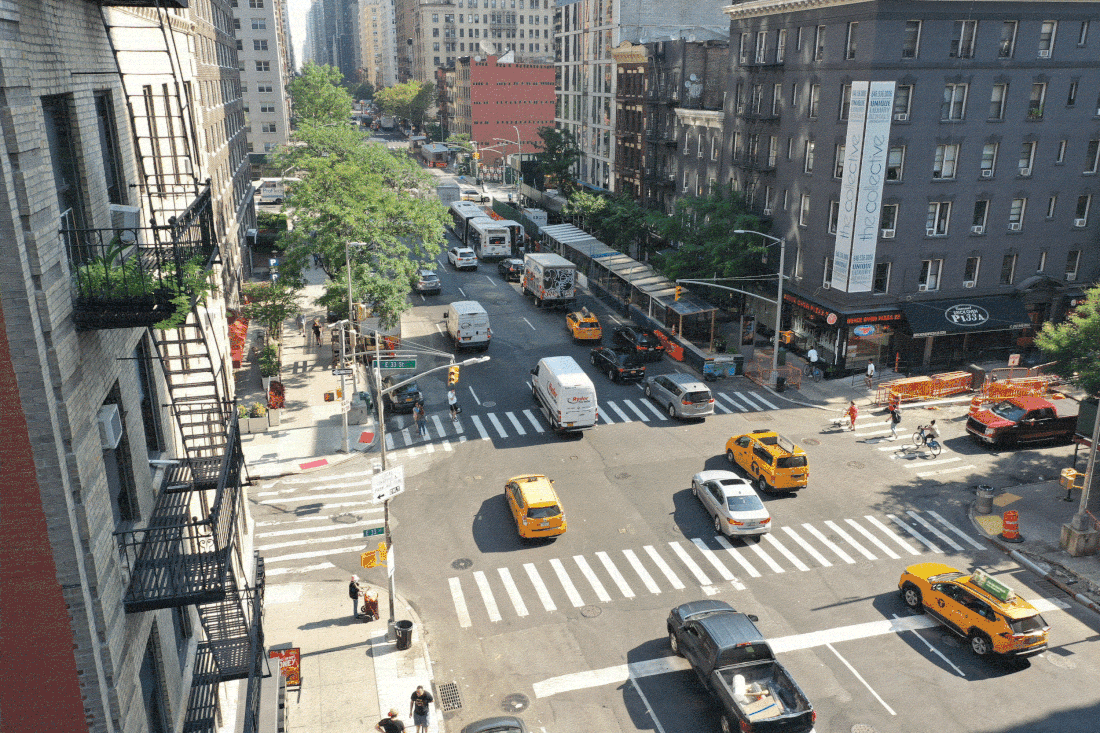DOT Design Toolkit Focus on Intersections
DOT announced that in 2022 it would undertake new and expanded efforts focused on intersection design at 1,000 locations, including through:
- Increased focus on intersections in Street Improvement Projects: DOT will use its full toolkit of street design treatments as redesigns happen, focused on Vision Zero priority geographies, locations where fatalities and serious injuries have occurred, and Priority Investment Areas as detailed in the NYC Streets Plan. These changes include new turn signals and “head-starts” that allow pedestrians to enter the intersection before vehicles can turn.
- Raised crosswalks: DOT will begin a program to construct 100 raised crosswalks at curb level annually. Raised crosswalks serve a dual purpose of increasing accessibility for the disability community, while at the same time serving as speed bumps that slow drivers. This work will be done primarily via a new contract with the New York City Department of Design and Construction.
- Bike corrals at intersections: DOT will “daylight” at least 100 intersections with bike corrals this year, as part of its planned installation of more than 10,000 bicycle racks by the end of 2022. Bike corrals at intersections help provide visibility for drivers, cyclists, and pedestrians, while preventing drivers from cutting corners and turning too quickly.
- Parking lot and gas station traffic-calming: Curb cuts at high-traffic locations like parking lots and gasoline stations, often at intersections, can create danger as drivers cut across sidewalks unpredictably — a particular concern for vulnerable student and senior pedestrians. DOT efforts will target dozens of problem locations, largely outside Manhattan, reducing driver “short cuts” and better channeling vehicle traffic to increase visibility and predictability.
- Doubling the Turn-Calming Program: Research has shown that drivers take turns more slowly and deliberately when physical elements are in place to force turns at more appropriate speeds. DOT will double the production of such efforts to 100 intersections this year.
Increased Enforcement Within Intersections
The NYPD will strongly enforce failure-to-yield (FTY), a violation that especially endangers pedestrians and cyclists at intersections, with a goal of doubling 2021 FTY enforcement efforts.
While enforcement will be at intersections citywide, officers will also be empowered by
a new DOT traffic rule that goes into effect today for such violations at over 1,200 intersections citywide that are governed by neither a traffic signal nor a stop sign. Under the new rule, drivers and cyclists passing through such intersections must not simply yield but fully stop until a pedestrian has completely crossed the street. The new rule is intended to clarify enforcement and remove any subjectivity from such violations.
New “Stop. Let Them Cross” Public Awareness Campaign
This month, DOT will begin a public awareness campaign on social media and in community and ethnic media publications to raise awareness for the new stop for pedestrians’ rule for uncontrolled intersections. The message also underscores the importance of slowing down and being aware of pedestrians while driving in New York City.
“Street safety is of paramount importance and redesigning our intersections will save lives,” said
State Assemblymember Robert Carroll. “I commend Mayor Adams and Transportation Commissioner Rodriguez for coming out of the gate intent on addressing these important safety issues early in their administration. I look forward to partnering on future improvements to make our streets safer.”
“Protecting pedestrians at dangerous intersections is paramount. As a City, we must prevent traffic fatalities and injuries, and ensure that our streets are safe for everyone,” said
City Council Speaker Adrienne Adams. “Implementing design improvements, visibility measures, and other treatments, combined with expanded enforcement and an education campaign, will make a tremendous difference. I thank Mayor Adams, DOT Commissioner Rodriguez, and Police Commissioner Sewell for taking these critical actions for the safety of all New Yorkers."
“I want to first express my sincere gratitude to Mayor Adams and Commissioner Rodriguez for their attention to this critical and life-threatening situation,” said
New York City Councilmember Shahana Hanif. “Nearly a month ago, Arcellie ‘Celi’ Muschamp tragically lost her life to a reckless driver on 5th Avenue and Union Street in my district. This community knows all too well the toll traffic violence can take and the desperate need to achieve Vision Zero. I am pleased to see the DOT implementing a few of the proposals I called for just this past Tuesday, such as daylighting intersections and improving street designs, especially with leading pedestrian intervals. By taking these important steps, we can prevent future tragedies and ensure our streets are safe for everyone.”
"The urgency of making our streets safer cannot be overstated,” said
New York City Councilmember Rita Joseph. “Intersections are where a disproportionate number of pedestrian traffic injuries occur, and I thank Mayor Adams and Commissioner Rodriguez for their data-driven focus on ensuring that our streetscape is people-focused. Crossing the street should not be a matter of life or death.”
“Bike New York thanks Mayor Adams and Commissioner Rodriguez for moving quickly to bring new traffic safety measures to city streets,” said
Jon Orcutt, advocacy director, Bike New York. “We need physical changes to slow dangerous driving: Raised crosswalks and bike corrals at corners will save lives. We also applaud the focus on curb cuts — we need improvements in this regard along bike lanes like Brooklyn’s 4th Avenue.”
“Regional Plan Association applauds Mayor Adams and Commissioner Rodriguez for fixing dangerous intersections and doing more to protect pedestrians,” said
Kate Slevin, executive vice president, Regional Plan Association. “Tragically, traffic fatality numbers were up in 2021, reaching the highest level since 2013. We look forward to working with the mayor and commissioner on a comprehensive approach to bring these numbers down and create a safer city for all. Efforts like this — with a focus on design, enforcement, and public awareness — will be fundamental to that broader strategy.”








